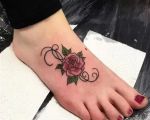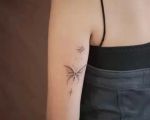How to Avoid Tattoo Infection: Essential Tips and Advice
Getting a tattoo is an exciting experience, but it’s also one that requires careful attention, especially when it comes to aftercare. As someone who has gotten several tattoos, I’ve learned firsthand how important it is to follow proper aftercare procedures to prevent any issues. One of the most common concerns after getting a tattoo is infection. In this article, I’m going to share some of the best tips and advice I’ve gathered over the years on how to avoid tattoo infection and ensure that your new ink heals perfectly.
1. Understanding Tattoo Infections
Before diving into the steps you can take to avoid a tattoo infection, it’s important to understand what causes it. A tattoo infection occurs when harmful bacteria enter the skin through the open wound created during the tattoo process. I’ve seen people get infections from improperly cleaned needles, unsanitary tattoo parlors, or even from touching the tattoo with dirty hands. The good news is, most infections can be avoided by following simple aftercare steps.
1.1 Common Signs of a Tattoo Infection
Knowing the signs of an infection is crucial. I’ve experienced minor irritation with some of my tattoos, but there’s a big difference between temporary discomfort and an infection. Some of the most common signs of a tattoo infection include:
- Excessive redness or swelling around the tattooed area
- Pain that worsens instead of improving after a few days
- Unusual discharge, like yellow or green pus
- Fever or chills, which could indicate a more serious infection
- Overwhelming itchiness or discomfort that doesn’t go away
If you notice any of these symptoms, it’s important to see a healthcare professional immediately. Early treatment can help prevent the infection from spreading or getting worse.
2. Proper Tattoo Aftercare
The key to avoiding a tattoo infection is proper aftercare. After all, your tattoo is essentially an open wound that needs to be treated with care during the healing process. I’ve always made sure to follow these steps after each tattoo to ensure the healing process goes smoothly and without infection.
2.1 Keep the Tattoo Clean
One of the most important things I do is to keep the tattoo clean. When I first get a tattoo, the artist typically covers it with a sterile bandage to prevent bacteria from entering. I keep the bandage on for a few hours, but once I remove it, I make sure to gently wash the tattoo with mild, unscented soap and lukewarm water. I avoid scrubbing or using any rough cloths, as that can irritate the skin. I use my hands to gently cleanse the area and pat it dry with a clean towel.
2.2 Apply an Antibacterial Ointment
After cleaning the tattoo, I apply a thin layer of antibacterial ointment to prevent any bacteria from settling into the skin. It’s crucial not to overapply ointment, as it can clog pores and prevent the skin from breathing. I’ve learned that a little goes a long way. In the first few days, I make sure to apply ointment every few hours, then transition to using a fragrance-free moisturizer once the tattoo starts to heal.
2.3 Avoid Picking or Scratching
As my tattoo starts to heal, it begins to itch, which is totally normal. However, I’ve learned that scratching or picking at the tattoo can lead to infection or scarring. It’s hard, but I’ve found that resisting the urge to scratch is key to a smooth healing process. If the itching is unbearable, I gently tap the area or apply some lotion to calm the skin. I also avoid wearing tight clothing over the tattoo that could cause irritation or rubbing.
2.4 Let the Tattoo Breathe
During the healing process, I’ve found it helpful to let the tattoo breathe as much as possible. This means avoiding tight, restrictive clothing over the tattooed area and ensuring that the tattoo gets plenty of air. I also avoid covering it with plastic wrap or bandages for extended periods, as this can trap moisture and bacteria, creating the perfect environment for an infection. Keeping the tattoo exposed to air helps it heal faster and reduces the risk of infection.
3. Avoiding Contact with Dirt and Bacteria
In the first few weeks after getting a tattoo, it’s important to avoid exposure to dirt and bacteria. I’ve always made sure to keep my tattoo away from unsanitary environments, like pools, hot tubs, or public showers, which are breeding grounds for bacteria. During this period, I also avoid touching the tattoo with dirty hands. When I need to touch the area, I make sure to wash my hands thoroughly beforehand.
3.1 Avoid Swimming
While it’s tempting to jump into a pool or the ocean to cool off, I always avoid swimming for at least two weeks after getting a new tattoo. Swimming in chlorinated water or saltwater can irritate the tattoo and introduce bacteria, increasing the risk of infection. I also stay away from saunas and hot tubs for the same reason. If I’m going to the beach or pool, I cover my tattoo with loose, breathable clothing or a bandage to protect it from water exposure.
3.2 Keep It Away from Animals
Another piece of advice I follow is to keep my tattoo away from animals, particularly pets that go outside. Animals can carry bacteria that could easily get into a fresh tattoo and cause an infection. I always make sure to wash my hands thoroughly after handling pets, and I try to keep the tattoo covered when interacting with animals to reduce any risk of contamination.
4. Monitoring Your Tattoo’s Healing Process
During the healing process, I constantly monitor my tattoo for any signs of infection. I’ve learned that being proactive can help catch any potential issues before they become serious. If I notice any signs of infection, such as increased redness, swelling, or pus, I seek medical advice immediately. I always make sure to follow up with my tattoo artist if I’m unsure about the healing progress or if I have any concerns.
4.1 Stay Hydrated and Eat Well
In addition to the basic aftercare steps, I’ve found that staying hydrated and eating a healthy diet can help with the healing process. Drinking plenty of water ensures my skin stays moisturized, which can speed up the healing process. I also focus on eating foods rich in vitamins A, C, and E, which help support skin health. These nutrients play an important role in promoting cell regeneration, which is crucial for healing tattoos properly.
4.2 Avoid Tight Clothing
Wearing tight clothing over a fresh tattoo can cause friction, irritation, and rubbing, which increases the likelihood of infection. I always wear loose, comfortable clothing over my tattoos during the healing process to allow the skin to breathe and avoid any unnecessary pressure or rubbing on the area. This also helps prevent any accidental damage to the tattoo as it heals.
5. When to Seek Professional Help
While minor irritation is normal during the tattoo healing process, there are certain situations where professional help is needed. If you experience significant pain, fever, or worsening symptoms, it’s important to seek medical attention right away. I’ve learned that early intervention is key to preventing a mild infection from turning into something more serious.
In conclusion, avoiding tattoo infections requires careful aftercare and attention to hygiene. By following these steps—keeping your tattoo clean, moisturizing, avoiding exposure to dirt and bacteria, and monitoring the healing process—you can help ensure that your tattoo heals beautifully and without complications. If you’re unsure about any aspect of your tattoo’s healing, don’t hesitate to reach out to your tattoo artist or a healthcare professional. For more information and guidance on tattoo aftercare, be sure to visit Inked Up Dolls, where you can find expert advice and resources to help you take care of your tattoos.








